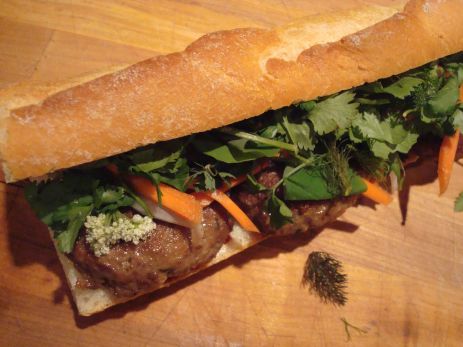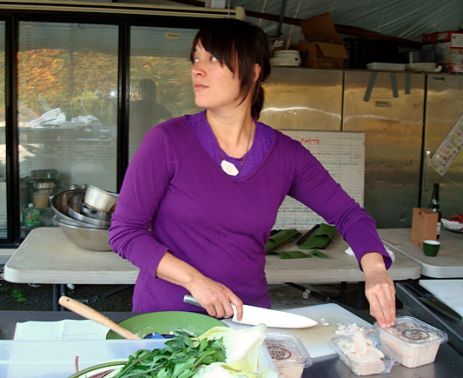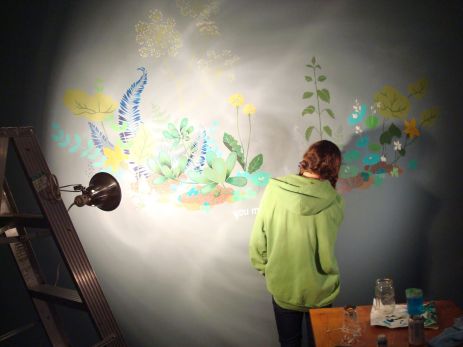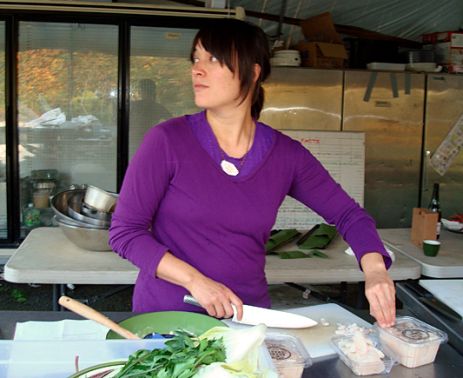From activists to politicians, everybody loves to talk about the promise of green jobs. But in reality, who the heck actually has a green job, and how do you get one? In our new column, “I Have a Green Job,” Grist will be regularly profiling one of the lucky employed who has landed a job in the new green economy, or a green job in the old economy.
Know someone with a green job and a good story? Tell us about them!
 A lemongrass elk meatball sandwich at Nettletown.Photo courtesy Christina ChoiThe newly opened Seattle café Nettletown sources ingredients from the wet forests surrounding Seattle, which makes for an interesting, commendable concept. But is the food any good? I couldn’t stop thinking of mushrooms and rabbits, the musty and the gamey, so I decided to take a taste before interviewing the owner.
A lemongrass elk meatball sandwich at Nettletown.Photo courtesy Christina ChoiThe newly opened Seattle café Nettletown sources ingredients from the wet forests surrounding Seattle, which makes for an interesting, commendable concept. But is the food any good? I couldn’t stop thinking of mushrooms and rabbits, the musty and the gamey, so I decided to take a taste before interviewing the owner.
The café has an unusual location. In the middle of the city in a strip mall, the eatery calls Subway its next door neighbor. And guess which one my hungover friend wanted to eat at? “It’s a bit pricey,” he sighed, ordering a huckleberry mimosa that cost about the same as a foot-long sub. He wondered why he could get a full meal out of a Biggest, Meatiest, Tastiest, while his smaller fried egg sandwich cost a dollar more.
I explained that locally grown, carefully selected food was bound to be more expensive. Instead of arriving in cardboard boxes, the food at Nettletown comes out of bins at farmers markets and from foraging deep in the surrounding Pacific Northwest forests. “Sounds fun. Maybe they should be paying us,” he joked, picking up half his sandwich.
——————————————–
Owner Christina Choi works 80–100 hours a week deciding the menu, sourcing and serving the food, and—her least favorite part—paying bills. It’s obvious the 32-year-old likes a challenge. She once threw together and published an illustrated wild foods calender in one month. And she co-founded a foraging company in 2001 when wild and sustainable food was still a radical concept.
 Christina ChoiPhoto courtesy Christina ChoiQ. Can you tell me a little bit about your menu? What percentage is from foraging?
Christina ChoiPhoto courtesy Christina ChoiQ. Can you tell me a little bit about your menu? What percentage is from foraging?
A. I wanted to have a casual café, not something where it was a different menu every day. It’s hard when you want to do seasonal and wild food as much as possible to figure out a way to do that.
I have a lot of pickled stuff on the menu. I’m planning to pickle as many sea beans as possible and see if I can pickle enough to have year-round and then find a lot of storage space.
I’m keeping something wild or seasonal on almost every menu item. I would say a third of the vegetables I’m using are foraged.
Q. How did Foraged and Found (the foraging company Choi started with Jeremy Faber and from which she still gets much of her foraged goods) come about?
A. It was all new territory. We foraged everything for the first year and did pretty much everything ourselves. As years went on, we got more and more people to help. But the first few years I really did a lot of foraging. I would do it one or two or three days a week and then take care of the delivering and the wholesale and the farmers market.
The thing that set us apart, and still sets us apart, from other purveyors is we’re not just some huge company selling whatever. We were chefs; we knew what good product was and were only selling good quality stuff and a range of ingredients no one else was doing.
And every year we do new stuff. Last year we did Japanese knotwood for the first time. I’ve never seen anyone else sell it. It’s a horrible noxious weed that grows a lot of places. We found things that had culinary qualities and figured out how to make it work. Jeremy’s still getting me great ingredients.
Q. What’s your favorite wild food to eat?
A. That’s hard. There are so many good wild foods. Huckleberries are great. I love mushrooms too—morels, porcinis. Wood sorrel. Devil’s club: That is something that I haven’t gotten to eat much of, but that’s one of my favorite wild foods. Right now is when you want to pick it, right when the first shoots come up. It’s green and hairy and soft, but then it has this really piney evergreen scent and taste. It’s very delicious.
Q. What sparked your interest in cooking?
A. My mom was in the food business. She was a recipe consultant developer. She majored in home ec in college. I have five brothers and sisters, so she was a stay-at-home mom. But she worked out of the home doing recipe development. So if she was doing Walla Walla onion recipes, we would eat Walla Walla onions for months in all these different forms. And I would help my mom in the kitchen all the time.
We always sat down to dinner every night. No TV. All together. I think that was a huge part of it. My dad’s Chinese, and he would cook a lot of Asian food. We would just eat all different types of food from around the world. But nothing fancy. I didn’t know what fancy food was at all until after high school.
Q. What sparked your interest in sustainable food?
A. As a chef, and for any cook, it just makes sense. Not just sustainable but also seasonal. And once you start wanting to cook more seasonal, the products you use are going to be from local farms. I think anyone with a conscience should be looking at sustainability. I think only lazy people don’t care.
I grew up in a family where you don’t waste food at all. And most restaurants are so wasteful. They don’t use every part of a vegetable. Whatever part doesn’t look good, if it isn’t a perfect shape, they just throw it away.
I really believe in using everything and not wasting any part of the vegetable. I think that’s part of sustainability: being resourceful and frugal.
 Friend Maija finishing up the Nettletown mural. Christina credits her friends and family for putting in a lot of work to get the restaurant up and running.Photo courtesy Christina ChoiQ. What do you think a green job is and why do you think your job is one of them?
Friend Maija finishing up the Nettletown mural. Christina credits her friends and family for putting in a lot of work to get the restaurant up and running.Photo courtesy Christina ChoiQ. What do you think a green job is and why do you think your job is one of them?
A. Green. I don’t know if I would use that word for many things in general. I like products that are biodegradable and sustainable. I would use it for products but not for me or what I’m doing. Do people actually use that?
Maybe I’m just not into terms. And I was really worried about being portrayed that way. I actually thought about this a lot when designing the logo and the face of the restaurant, so people wouldn’t think this was just an “organic, hippie café.” Which I think that I am a little bit. I was just telling one of my employees that it’s just a glorified hippie café.
But I didn’t want green in my logo, because I didn’t want people just to pigeonhole it and have that disclude some people in being interested in coming here.
Q. What part of your job makes you most hopeful about the future of sustainable food?
A. People are interested in wild foods and are more and more familiar with them. So it’s nice to see that people aren’t pushing it away. It’s not so foreign. It’s just part of the fabric of a lot of urban life now.
It’s exciting to see people opening businesses right now. A lot of people in the business are doing things that they are very passionate about, and they are trying to do it in a way that sticks with their values and sticks with sustainability values. They just want to share great things and great producers and to support other great businesses.
Q. What are your hopes for the restaurant?
A. I really wanted to make a place where people could stop in any time, get something big or small, and see people in the neighborhood. A really community-oriented place where the cooks at the counter know all the regulars, and it’s a nice place to go with homey, casual, satisfying food.
Q. What’s the best part of being a restaurant owner?
A. Getting feedback from customers and seeing the people who are really happy and love the food. The best part is when people tell me how great and nourishing the food is.
——————————————–
I watched my friend during that first bite. His eyes brightened, his shoulders relaxed, and his mouth—had it not been full of sweet cicely, cilantro, wood sorrel, miner’s lettuce, mint, lemon balm, bronze fennel, pickled carrots and onions, fried organic eggs, and French bread—might have uttered “oh.” He struggled to finish half the sandwich and asked for a box for the rest.


